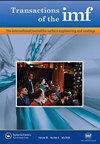化学镀铜镍合金镀层的制备及其电阻特性
IF 1.5
4区 材料科学
Q4 ELECTROCHEMISTRY
Transactions of The Institute of Metal Finishing
Pub Date : 1998-01-01
DOI:10.1080/00202967.1998.11871231
引用次数: 9
摘要
研究了柠檬酸盐络合浴中以次亚磷酸酯为还原剂制备的化学铜镍磷合金和三乙醇胺络合浴中以甲醛为还原剂制备的化学铜镍二元合金。随着合金中铜含量的增加,镀层比电阻降低。热处理后,由于Ni3P的结晶,铜镍磷合金的TCR显著提高。但铜镍二元合金的TCR增加幅度不大,不像含磷合金那样明显。本文章由计算机程序翻译,如有差异,请以英文原文为准。
Preparation and Electrical Resistance Characteristics of Electroless Copper-Nickel Alloy Deposits
SummaryStudies have been made of an electroless copper-nickel-phosphorus alloy from a citrate complex bath using hypophosphite as reducing agent and electroless copper-nickel binary alloy from a triethanolamine complex bath using formaldehyde as reducing agent. With an increase in copper content of alloy, the specific resistance of deposit decreased. The TCR of copper-nickel-phosphorus alloy increased remarkably because of the crystallization of Ni3P after heat treatment. But the increase in TCR of copper-nickel binary alloy was moderate and not so striking as for the phosphorus containing alloy.
求助全文
通过发布文献求助,成功后即可免费获取论文全文。
去求助
来源期刊

Transactions of The Institute of Metal Finishing
工程技术-材料科学:膜
CiteScore
3.40
自引率
10.50%
发文量
62
审稿时长
3 months
期刊介绍:
Transactions of the Institute of Metal Finishing provides international peer-reviewed coverage of all aspects of surface finishing and surface engineering, from fundamental research to in-service applications. The coverage is principally concerned with the application of surface engineering and coating technologies to enhance the properties of engineering components and assemblies. These techniques include electroplating and electroless plating and their pre- and post-treatments, thus embracing all cleaning pickling and chemical conversion processes, and also complementary processes such as anodising. Increasingly, other processes are becoming important particularly regarding surface profile, texture, opacity, contact integrity, etc.
 求助内容:
求助内容: 应助结果提醒方式:
应助结果提醒方式:


